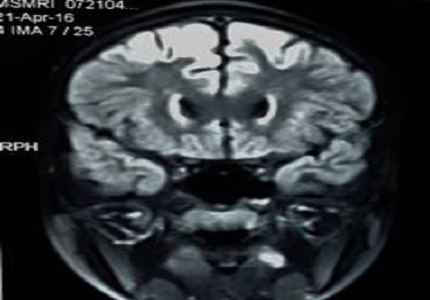Neuro Wilson disease in an adolescent girl – early presentation- a case report
Abstract
Wilson disease (WD) is an inborn error of copper metabolism caused by a mutation to the copper-transporting gene ATP7B. The disease has an autosomal recessive mode of inheritance, and is characterized by excessive copper deposition, predominantly in the liver, cornea, kidney and brain. There are varied clinical presentations for WD. The prognosis depends on various factors like age, sex, organ involvement, time of diagnosis, early initiation of de-coppering therapy and extent of involvement in case of neurowilson disease. In WD excessive copper accumulates in liver then gets redistributed to nervous system, cornea, kidneys and other organs. In first decade of life, hepatic involvement predominates but neurological manifestations occur in third or fourth decade. Studies showed Indian children with neurowilson disease present with behavior abnormality, speech and cognitive impairment, sub-clinical affection of visual pathway and autonomic function.
Here we present a 12 years old girl with primary neurological manifestation of Wilson disease. She presented with abnormal gait, dysarthria and inappropriate laughter. On examination she also had Kayser- Fleischer (KF) ring in both eyes and MRI revealed extensive gray and white matter abnormalities, which suggest poor prognosis in the index case. In spite of good compliance with de-coppering therapy with D- penicillamine and zinc, she had progressive neurological deterioration in the form of progressive dystonia, dysarthria and difficulty in walking.
Downloads
References
2. El-Youssef M. Wilson disease. Mayo Clin Proc. 2003 Sep;78(9):1126-36. DOI:10.1016/S0025-6196(11)62937-6. [PubMed]
3. Deiss A. Cecil textbook of Medicine. 20th ed. Singapore: Harcourt Asia Pte Ltd; 1999. 1131-2.
4. van Wassenaer-van Hall HN, van den Heuvel AG, Jansen GH, Hoogenraad TU, Mali WP. Cranial MR in Wilson Disease: Abnormal white matter in extra pyramidal and pyramidal tract. Am J Neuroradiol 1995;16(10):2021-7.
5. vanWassenaervanHall HN, vandeneuvel AG, Algra A, Hoogenraad TU, Mali WP. Wilson Disease: Findings at MR imaging and CT of the Brain with clinical correlation. Radiology 1996; 198(2): 531-36. DOI:10.1148/radiology.198.2.8596862. [PubMed]
6. Prashanth LK, Taly AB, Sinha S, Ravishankar S, Arunodaya GR, Vasudev MK, et al. Prognostic factors in patients presenting with severe neurological forms of Wilson's disease. QJM 2005;98 (8):557-63. DOI:10.1093/qjmed/hci095. [PubMed]
7. Aikath D, Gupta A, Chattopadhyay I, Hashmi MA, Gangopadhyay PK, Das SK, et al. Subcortical white matter abnormalities related to drug resistance in Wilson disease. Neurology 2006;67(5):878-80.

Copyright (c) 2016 Author (s). Published by Siddharth Health Research and Social Welfare Society

This work is licensed under a Creative Commons Attribution 4.0 International License.


 OAI - Open Archives Initiative
OAI - Open Archives Initiative


